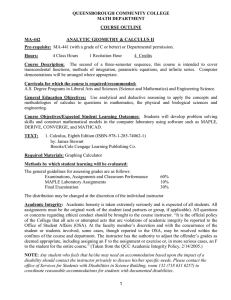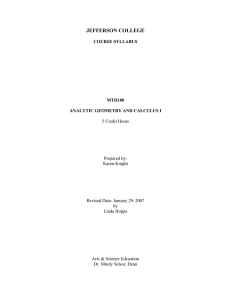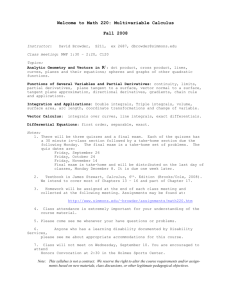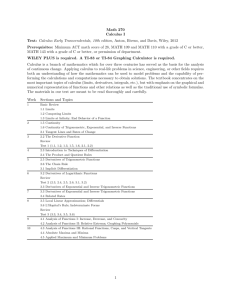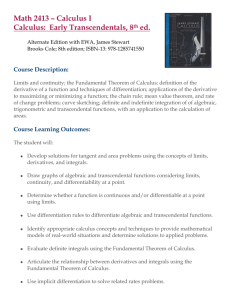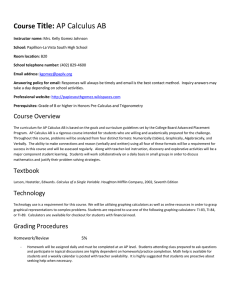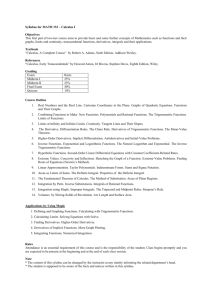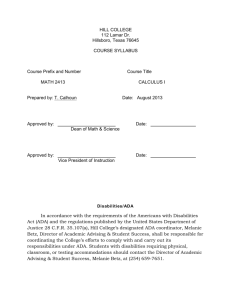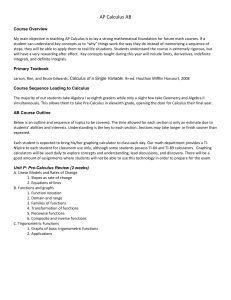MA 441: Analytic Geometry and Calculus I
advertisement
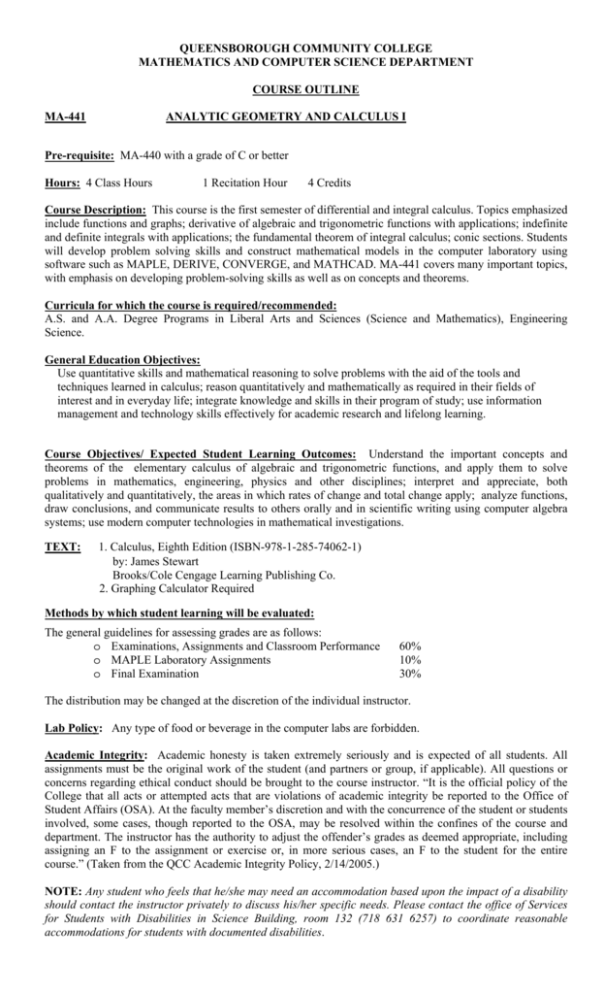
QUEENSBOROUGH COMMUNITY COLLEGE MATHEMATICS AND COMPUTER SCIENCE DEPARTMENT COURSE OUTLINE MA-441 ANALYTIC GEOMETRY AND CALCULUS I Pre-requisite: MA-440 with a grade of C or better Hours: 4 Class Hours 1 Recitation Hour 4 Credits Course Description: This course is the first semester of differential and integral calculus. Topics emphasized include functions and graphs; derivative of algebraic and trigonometric functions with applications; indefinite and definite integrals with applications; the fundamental theorem of integral calculus; conic sections. Students will develop problem solving skills and construct mathematical models in the computer laboratory using software such as MAPLE, DERIVE, CONVERGE, and MATHCAD. MA-441 covers many important topics, with emphasis on developing problem-solving skills as well as on concepts and theorems. Curricula for which the course is required/recommended: A.S. and A.A. Degree Programs in Liberal Arts and Sciences (Science and Mathematics), Engineering Science. General Education Objectives: Use quantitative skills and mathematical reasoning to solve problems with the aid of the tools and techniques learned in calculus; reason quantitatively and mathematically as required in their fields of interest and in everyday life; integrate knowledge and skills in their program of study; use information management and technology skills effectively for academic research and lifelong learning. Course Objectives/ Expected Student Learning Outcomes: Understand the important concepts and theorems of the elementary calculus of algebraic and trigonometric functions, and apply them to solve problems in mathematics, engineering, physics and other disciplines; interpret and appreciate, both qualitatively and quantitatively, the areas in which rates of change and total change apply; analyze functions, draw conclusions, and communicate results to others orally and in scientific writing using computer algebra systems; use modern computer technologies in mathematical investigations. TEXT: 1. Calculus, Eighth Edition (ISBN-978-1-285-74062-1) by: James Stewart Brooks/Cole Cengage Learning Publishing Co. 2. Graphing Calculator Required Methods by which student learning will be evaluated: The general guidelines for assessing grades are as follows: o Examinations, Assignments and Classroom Performance o MAPLE Laboratory Assignments o Final Examination 60% 10% 30% The distribution may be changed at the discretion of the individual instructor. Lab Policy: Any type of food or beverage in the computer labs are forbidden. Academic Integrity: Academic honesty is taken extremely seriously and is expected of all students. All assignments must be the original work of the student (and partners or group, if applicable). All questions or concerns regarding ethical conduct should be brought to the course instructor. “It is the official policy of the College that all acts or attempted acts that are violations of academic integrity be reported to the Office of Student Affairs (OSA). At the faculty member’s discretion and with the concurrence of the student or students involved, some cases, though reported to the OSA, may be resolved within the confines of the course and department. The instructor has the authority to adjust the offender’s grades as deemed appropriate, including assigning an F to the assignment or exercise or, in more serious cases, an F to the student for the entire course.” (Taken from the QCC Academic Integrity Policy, 2/14/2005.) NOTE: Any student who feels that he/she may need an accommodation based upon the impact of a disability should contact the instructor privately to discuss his/her specific needs. Please contact the office of Services for Students with Disabilities in Science Building, room 132 (718 631 6257) to coordinate reasonable accommodations for students with documented disabilities. TOPIC SECTIONS HOURS LIMITS The Tangent and Velocity Problems 1.4 1 The Limit of a Function 1.5 2 Calculating Limits Using the Limit Laws 1.6 2 Continuity 1.8 2 2.1, 2.2 3 Differentiation Formulas 2.3 2 Derivatives of Trigonometric Functions 2.4 2 The Chain Rule 2.5 2 Implicit Differentiation 2.6 1 Rates of Change in the Natural and Social Sciences 2.7 1 Related Rates 2.8 2 Linear Approximations and Differentials 2.9 2 Maximum and Minimum Values 3.1 2 The Mean Value Theorem 3.2 2 First and Second Derivative Tests 3.3 3 Limits at Infinity; Horizontal Asymptotes 3.4 1 Curve Sketching 3.5 2 Graphing with Computers and Calculators 3.6 1 Optimization Problems 3.7 1 Antiderivatives 3.9 2 Areas and Distances 4.1 2 The Definite Integral The Fundamental Theorem of Calculus, and Indefinite Integrals The Substitution Rule 4.2 2 4.3, 4.4 2 4.5 2 5.1 2 DERIVATIVES Derivatives and Higher Derivatives APPLICATIONS OF DIFFERENTIATION INTEGRALS APPLICATIONS OF INTEGRATION Areas Between Curves REVIEWS 8 EXAMS + FINAL EXAM 6 COMPUTER LABORATORY 15 TOTAL 75 The approximate hours per chapter are guidelines and are at the discretion of the instructor. The instructor is responsible for making assignments and scheduling examinations. TR/MF:cs FALL 2015 [MATHMA-441 SYL FALL 2015]

